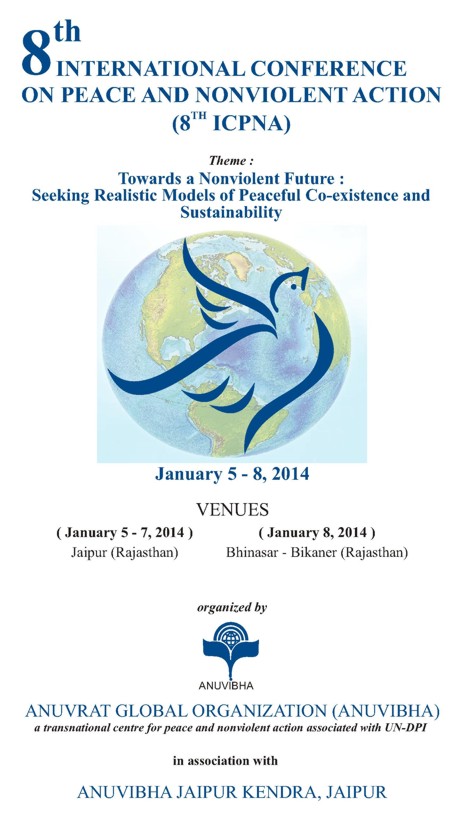 | 8th International Conference on Peace and Nonviolent Action |
The philosophical foundation of Jainism is erected on the notion that the Soul is immortal, there is rebirth, Soul migrates as per one’s own deeds (karmas) and the Soul can attain emancipation.[1] It is this knowledge that constitutes the path of emancipation.
The concept of soul, rebirth and emancipation are metaphysical aspects of Jain Philosophy. All the religious practices, worship, preaching’s, rites and rituals assumes such fundamental metaphysical doctrines in their own context. They are so framed that produce strong conviction in realities, to say, that appear idealistic and non realistic to people in general. The present paper attempts to establish the fact that the anuvrat doctrine as enunciated by H.H. Āchārya Tulsi is like breaking the boundaries. It sets Anuvrat on a more realistic platform. This is to say that anuvrat follows a more empirical-realistic approach. Anuvrat in fact, truly establishes Jainism as a realistic school of thought because, it does not pre-suppose any of the metaphysical assumptions as traditionally accepted in philosophical discourses.
Meaning and Source of the Anuvrat Doctrine
Anuvrat is a minimum moral code of conduct. Etymologically ‘anu’ means small and ‘vrata’ means vow. Thus, anuvrat means small vows. Anuvrat is a non-vigilant practice of small vows. The source of this doctrine lies in the two-fold path of religion (dharma) as enunciated by Lord Mahavira:
- Agara (homely),
and- Anagara (homeless)
These two paths are available for every spiritual aspirant. Anuvrat, however as a doctrine is equated with agaara dharma. We may inquiry, why anuvrat as doctrine is coined and exaggerated to be the dharma by H.H. Āchārya Tulsi. This is because in this modern contemporary world an ambiance of fear has pervaded everywhere. There is fear all over, here, there and everywhere. In this ambiance of fear if there is any element of fearlessness, we must discuss it at first place.
The Bhagavad Gītā very rightly, states,
Svalpmapyasya dharmasya trāyate
mahato bhayātThat is, even a small fragment of faith (religion) can provide protection to humankind against great fears and can make him audacious. In the very same lines, Āchārya Tulsi beautifully asserts,
Anurapi vratasyasya trāyate mahato
BhayātWhich means, a small vow - the anuvrat doctrine - can provide shelter to the nation and the entire human race against great fear. In order to give a message of fearlessness to the whole of humankind it is essential for man’s conviction to grow in this direction. This can happen when humankind illusions are effaced.
H.H. Āchārya Tulsi admits that anuvrat doctrine stands on realistic ground. A delusion free practical approach of anuvrat doctrine can serve solutions to the contemporary problems. True conviction in the assumptions of anuvrat doctrine can turn true this saying, ‘Anurapi vratasyasya trāyate mahato bhayāt’ small vows will be able to save humans from great fears.Anuvrat Doctrine in a Realistic Frame
We may legitimately inquire, is there any scarcity of religions? Innumerable, uncountable religions exist throughout the globe. What could be the motive behind commencing one more new religion in the name of ‘Anuvrat’? Does it make any sense in expanding the quantity aspects of religions? All these are valid inquiries concerning anuvrat.On scrutinizing these issues, we are disclosed to the fact that, if the anuvrat doctrine becomes a religion carved into a community then all these questions would have come true. Nevertheless, those who understand the anuvrat doctrine never indulge in such arguments.
There are however, certain arguments based on realistic standpoints to establish what are ‘Anuvrat’ and why was it initiated. In the so called modern contemporary world religion and community have became one, sect and religion are strongly integrated. There are altercations in the name of sect but religions are defamed. Combats are in the name of sects, bloodshed and slaughtering occur because of sect, and again religions are calumniated. Such a scenario stormed the brain of H.H Āchārya Tulsi and inspired him to seek out a way by which sect and religion are segregated. The enquiry led to seek answers of the following questions:“Can there be any religion that is only a religion, neither a sect, nor a community?” If this is, a non-realist enquiry, better accept religion and sect as one. However, if both are non-identical and different then their appearance should come forth.
Anuvrat Doctrine beyond Metaphysics
In the background of these enquires a layout of the anuvrat doctrine was prepared and presented. It was rather a philosophical transition period in Jain history. Anuvrat philosophy was addressing more realist questions in context of contemporary issues. It aimed to address the fundamental moral crisis in a religion cum socio-political structure. The basic assertion of this philosophy is that ‘anuvrat’ is a religion, but not a sect. It is a religion but not a community.’
A person of any community, upholding his community as it is, maintaining his attire, carrying on his rituals, shall become anuvrati (practitioner of small vows). This will help to emerge a non-secular religion. Likewise, if the renowned person of the nation India accepts ‘Anuvrat’, then the conflicts between the religions will be over. Thus, the only intent behind formation of anuvrat was non-sectarian religion.
The success of this objective can help to achieve the notion of universal Religion. This was the foremost intention.
Secondly, religion and rituals were so intertwined that Religion means rituals. Religion means worship. Religion means prayer. Religion means attire, to keep a scalp lock, or to keep a beard. Religion means to take Ganga bath, Religion means not to bath at all, Religion means to go to mosque, Religion means to go to temple and all these practices are attributed to Religion.
All these are serious modes of going astray and sometimes even toward perversity. Anuvrat doctrine claims itself to be Religion devoid of all these. One who worships regularly, chants regularly, takes Ganga-bath regularly, who is a regular practitioner of something, if at the same time he is immoral and lacks character then in no sense such people be claimed to be religious. This analysis led to the establishment of the notion that religion and rituals are two separate entities.
As an outline of ‘Anuvrat’ it could be clearly stated that, ‘Anuvrat’ does not consists of any ritual. One is free to chant a Mantra or not, to go to a religious place or not, the way you dress up. The sure short path directed by Anuvrat religion is character and morality is primary aspects whereas worship is secondary. Conduct stands at first place whereas rituals come at second.
To justify this aspect of Religion the framework of ‘Anuvrat’ was drawn. Thus, ‘Anuvrat’ is a Religion, but is neither worship nor ritual. This is the reason that a Christian performing the rituals of Christians can become ‘Anuvrati’. An Islamic performing the rituals of Islam can become ‘Anuvrati’. An ascetic, a Jain follower and all other following their own ideologies can become so.
Thirdly, the problem is, there are no Religions devoid of adjectives, viz., Jain Religion, Hindu Religion, Buddha religion, Islam religion, Christian religion, so on and so forth. ‘Anuvrat’ is a religion with no adjective attached to it. All Religions are integrated in it yet there is no monolithic position of any particular religion. Religions free of any adjectives can exist and to prove this layout, the ‘anuvrat doctrine’ was unveiled.Fourthly, almost all religions explain methods and precautions to be taken to improve future life. They try to address the metaphysical problem of rebirth through the mythological narrations and historical events. These concerns sometimes overlook the present catastrophes and evils. Domination of such attitudes in the society makes it dead and deficient. Thus, the basic four assumptions of anuvrat doctrine foster reverence and respect for other religions, ideologies and tolerance towards contradictory views and precepts.
The Anuvrat doctrine aims to show a path that does not focus upon the concept of rebirth but explains to purify socio-political structure of the present society. It rather demands to set aside the worries of the future lives and deem value to make the present life to be ethical good and socially moral.It assets that present is the mirror of future. If one’s present is pure then future will naturally be pure. If it is blemished then future will certainly be so.Therefore, ‘Anuvrat’ proclaims: first become virtuous in this life before thinking of improving your next life. Therefore, the doctrine, which admits purification of only
‘Present’ is ‘Anuvrat’. How essential and indispensable it is to enhance the socio-political structure of the contemporary era.
Anuvrat Doctrine and Pragmatic Necessities
‘Anuvrat’ is not a bypass way to religion. It requests concrete action strategies. The first and foremost pragmatic prerequisite of this doctrine is transformation of habits. Transformation of habits is far more complex phenomenon. Thus, though realistic form of doctrine individuals are scared of being ‘Anuvrati’ (practitioners of small vows). This is because the difficulty before ‘Anuvrati’ is a business Anuvrati will not be able to adulterate things, a student Anuvrati will not be able to undertake cheating in exams, government employee Anuvrati will not be able to accept a bribe, a religious anuvrati will not be a fundamentalist, so on and so forth.
Thus, Anuvrat aims peaceful coexistence and world peace, being sensitive towards human problems, restraint-full towards environmental crisis, spiritually and morally vigilant in everyday walk of life. The declared slogans of this doctrine are:
Sanyamh khalu jeevanam.
(Self-restraint is life.)
Nij par shashan, phir anushashan
(First, discipline oneself, then others)
Hum sub ek hai
(We all are one.)
Pahle Insaan-Inssan, phir hindu ya musalman
(Man first man then either Hindu or Muslim.)The Anuvrat doctrine in its true sense justifies Jain philosophy to be realistic in its approach. It is an epoch in the entire history of Jain philosophy to have such an extensive doctrine addressing the socio-political structure devoid of any metaphysical assumption. (Late) Āchārya Tulsi’s tremendous academic contribution justifies development in Jain philosophy. His philosophical insight, which emerged as Anuvrat doctrine drew new lines in a contemporary perspective, making it truly realistic and empirical.
 Dr. Samani Rohini Pragya
Dr. Samani Rohini Pragya